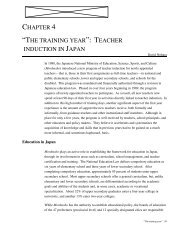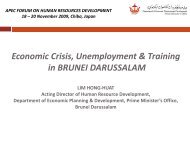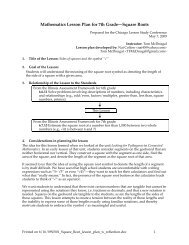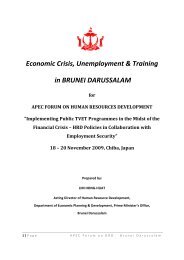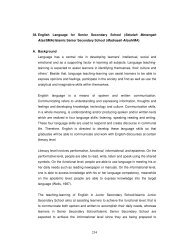Quality Assurance Systems in Asia-Pacific Economic Cooperation
Quality Assurance Systems in Asia-Pacific Economic Cooperation
Quality Assurance Systems in Asia-Pacific Economic Cooperation
You also want an ePaper? Increase the reach of your titles
YUMPU automatically turns print PDFs into web optimized ePapers that Google loves.
ENHANCEMENT OF QUALITY ASSURANCE SYSTEMS IN HIGHER EDUCATION IN APEC MEMBER ECONOMIES<br />
power to award degrees, and approval to offer programs, the <strong>in</strong>itiative to establish such a<br />
quality assurance system would come from the government. When it is expected that other<br />
countries or governments or states will recognise and accept the quality assurance decisions,<br />
the government will have a much greater say <strong>in</strong> the establishment, organisation and operation<br />
of the quality assurance system. Sometimes the national context may require that QA<br />
outcomes serve specific governmental functions and <strong>in</strong> such cases governments have a<br />
major role <strong>in</strong> the establishment as well as the function<strong>in</strong>g of the QA system. For example, <strong>in</strong><br />
the case of Brunei Darussalam, the survey <strong>in</strong>dicates that ‘Accreditation <strong>in</strong> the context of<br />
Brunei Darussalam is solely for the purpose of employment with<strong>in</strong> the government sector.<br />
This is <strong>in</strong>deed significant s<strong>in</strong>ce Brunei government is a major employ<strong>in</strong>g authority amount<strong>in</strong>g<br />
to 60–70% provid<strong>in</strong>g employment.’ That, and the fact that Brunei has a small system of higher<br />
education, expla<strong>in</strong>s to some extent the direct role of government <strong>in</strong> the function<strong>in</strong>g of BDNAC.<br />
Serv<strong>in</strong>g government functions does not mean that the quality assurance system has to be<br />
solely governmental. The QA body may be a public organisation, <strong>in</strong>dependent from the<br />
government, but part of the public system as <strong>in</strong> the case of CNAP, HKCAA, AUQA and BAN-<br />
PT. There are other quality assurance systems that are not a part of the public system but<br />
recognised nationally, and <strong>in</strong>ternationally. The accreditation system of the USA is an<br />
example. When the ma<strong>in</strong> purpose of quality assurance is the academic activities of an<br />
<strong>in</strong>stitution, HEIs tend to play a central role. When the purpose is to ensure that professionals<br />
are tra<strong>in</strong>ed <strong>in</strong> accordance to the norms of the guild, professional associations come to the<br />
fore.<br />
2.3 Legal Basis<br />
In almost all cases, the basis for the QA agency and its authority is a government law, or its<br />
equivalent <strong>in</strong> the respective jurisdictions. In a few cases, the authority is governmental but not<br />
through means of a law. There are examples of an ord<strong>in</strong>ance (HKCAA), a statute (SPRING),<br />
government recognition or mandate (JUAA, HEEACT, AACCUP, PAASCU), a government<br />
committee (UGC), governmental agreement (AUQA), delegation from a legislated body (ITP-<br />
Q), and Royal decree (BDNAC). In only the US regional accreditors, the NZUAAU and CUAP,<br />
and the OCGS does the authority come directly from the <strong>in</strong>stitutions themselves.<br />
As the rest of this survey shows, there are some tendencies that may be detected as oriented<br />
towards the legal ownership, but these are very slight. Dist<strong>in</strong>ctions between agencies cluster<br />
primarily along other dimensions.<br />
2.4 Governance<br />
The survey confirms that <strong>in</strong> all the QA <strong>in</strong>itiatives there is a govern<strong>in</strong>g body/board (GB) at the<br />
policy-mak<strong>in</strong>g level that steers the policies and objectives of the quality assurance exercise<br />
and there is another level of staff structure with responsibilities to translate the policies <strong>in</strong>to<br />
action. The govern<strong>in</strong>g board may have members appo<strong>in</strong>ted or nom<strong>in</strong>ated or elected<br />
accord<strong>in</strong>g to the rules of the organisation.<br />
The govern<strong>in</strong>g boards usually have representation from a cross-section of the various<br />
stakeholder groups of higher education who br<strong>in</strong>g <strong>in</strong> different backgrounds and expertise to<br />
the govern<strong>in</strong>g board. MQA states that its board has a ‘Chairman and n<strong>in</strong>e members<br />
represent<strong>in</strong>g government, employers, the professions and public and private HEIs, and five<br />
from amongst persons with experience and shown capacity and professionalism <strong>in</strong> matters<br />
relat<strong>in</strong>g to higher education or employment, or to be otherwise suitable for appo<strong>in</strong>tment<br />
because of their special knowledge and experience <strong>in</strong> higher educational or professional<br />
programs and qualifications’.<br />
Comisión Nacional para la Evaluación de la Educación Superior (Conaeva), established by<br />
the government of Mexico does <strong>in</strong>stitutional evaluation of the public universities and technical<br />
<strong>in</strong>stitutes. It is a 10-member commission with both government and universities represented<br />
<strong>in</strong> its govern<strong>in</strong>g board.<br />
6



